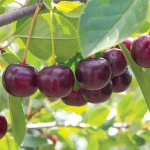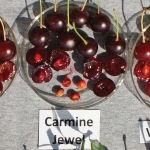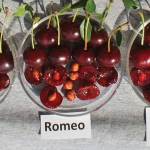New “prairie” cherry varieties from Dr. Bob Bors’s fruit breeding program at University of Saskatchewan haven’t yet cracked into the really big production areas, but are having a significant local effect.
Bors said the dark red sour cherries sell like hotcakes in farmers’ markets in Canada’s prairie province.
“Local growers are getting good money for the cherries—$5 and even $10 for a liter box,” he said.
Part of his mission is to supply locally grown fruit in an area that is much too cold for commercial orchards and vineyards. But he’d really like to bring his unique cherries into the larger world of commercial production, in North America and in Europe.
The six named Romance-series varieties and some yet to be released have been planted in Michigan at the Clarksville Experiment Station, joining a collection of varieties being observed by Michigan State University cherry breeder Dr. Amy Iezzoni.
But the prairie cherries face some hurdles if they are to capture the hearts of commercial tart cherry growers.
First, the cherries aren’t like Montmorency, the dominant tart cherry variety commercially grown in Michigan and a few other states—Washington, New York, Pennsylvania, Wisconsin, Utah, and Oregon—and also in Ontario. That variety has clear flesh and a light red skin and is quite tart.
The cherries from Bors’s program resulted from crosses of European varieties, which are sweeter amd have dark red skin and flesh, and varieties from central Asia, chosen because they are winter hardy. In his area of Canada around Saskatoon, winter temperatures fall below -40˚F five to ten nights a year, Bors said. The temperature dropped to -52˚F one year, and routinely reaches -20˚F. Bors is pretty sure the varieties won’t be hurt by winters elsewhere.
Still, he’s evaluating how well they will survive spring frosts. “Weather progresses from cold to warm pretty fast here,” he said. “We have fewer late spring frosts than Michigan does.”
Darker, sweeter

Color card for Cupid Cherry.
This card was created for Canadian Cherry Producers, Inc. by the University of Saskatchewan fruit program. Data are based on dates from 2010, which was a cold wet season, and will likely vary each year.
(Source: Bob Bors, University of Saskatchewan)
In Michigan, growers had shown some interest in growing dark red varieties and planted a Hungarian variety called Balaton. However, that variety has been plagued with low yields caused by poor pollination, a problem they have yet to solve.
As the tart cherry industry moves away from desserts and pie filling toward more dried and juice products, Bors believes the Saskatchewan cherries will be attractive because they are sweeter and darker. While Montmorency cherries have a Brix of about 14, the Romance cherries in Bors’s program are at least 16. The sweetest one, Crimson Passion, can reach 25 Brix at full ripeness.
Machine harvest
Bors believes his cherries might find a better niche in Europe.
In Poland, a large producer of tart cherries, growers like their dark red, sweeter varieties, and they have also moved toward over-the-row mechanical harvesting, treating cherries more like bush or vine crops, such as blueberries, caneberries, and grapes.
That’s being tried in Michigan. Last year, one grower used a blueberry harvester to harvest cherries from Montmorency trees he had pruned to a shorter, bushier shape and planted in hedgerows. Other growers are following that direction and will be harvesting their first plantings this year.
That’s a key virtue of Bors’s cherries. The dwarf, bush-type trees were selected for two reasons. First, Bors said, local growers could add them to their farms where they were already growing haskaps and saskatoons and harvesting them with an over-the-row harvester. Adding cherries would provide an August crop to harvest, using the same machine, following haskaps in June and saskatoons in July. These berries also grow on bushes.
The second reason was to lessen the effects of winter injury. The bush cherry varieties may lose some wood to frigid winters, but new shoots from ground level would renew the plants, unlike trees growing on trunks.
Bors, who heads a small department in which he has teaching and extension duties as well as research, is moving ahead slowly to make commercial production of his cherries more feasible. He is getting financial support from the Canadian Cherry Producers Association.
Ongoing testing
Bors is evaluating the six varieties, called the Romance series, named Romeo, Juliet, Cupid, Valentine, Crimson Passion, and Carmine Jewel. He wants to know more about their disease resistance.
“It’s generally pretty dry here, so we don’t have much disease pressure,” he said. “But we have had five wet seasons in a row. We have been getting brown rot.”
In Michigan and other humid eastern states, cherry leaf spot is a serious problem in Montmorency, and resistance to that disease is a key element in Iezzoni’s breeding program.
“Are ours resistant? I really doubt that,” Bors said. “They’re probably kind of average.”
The named varieties and some elite selections are also being evaluated for their qualities when used to make dried cherries, sugar-infused cherries, cherry jerky, wine, and when processed into canned, maraschino, and IQF (individually quick frozen) products.
Bors is continuing his breeding efforts with what he calls “third-generation” cherry trees. So he is tending new seedlings and evaluating them. He is releasing new varieties. Two, unnamed, may be released soon.
New varieties
“One of them is upright, and one is bushier,” he said. “The upright one has bright red fruit, like Montmorency, but is sweeter. I’m not sure what the niche might be for that one. Might there be a place for a more cold hardy Montmorency-like cherry? Maybe it would thrive in Michigan on sites further away from the lake.”
Most Michigan cherries are grown close to Lake Michigan, which buffers the cold of winter and keeps spring cool longer, protecting the early blossoming trees from spring freezes. Most of the cherries are grown close to the lake.
“I’ve heard reports from Ontario that the Romance cherries are ripening earlier than Montmorency,” Bors said. “While they fruit in early August in our location, farther south they should be much earlier. That will be something to watch in the Michigan trial as spreading out harvest time could be a boon for larger production.”
Harvest timing
Bors is teaching growers how to harvest the Romance fruit at the proper time. Growers who associate the light redness of Montmorency with ripeness need to learn a new standard, he said.
He has developed color charts for each of the six varieties, which are slightly different in color from each other and near black when fully ripe (see “Color card for Cupid cherry”). He wants growers to be able to use color to tell when the highest Brix levels have been reached.
The last few summers, which were cool and wet, have made the research difficult because the fruit doesn’t reach the full sweetness they might achieve—and as they get riper, brown rot has emerged as an issue.
The color charts have been published as harvest index cards for growers to use.
Each of the six varieties of dwarf sour cherries has its own special characteristics, which may not be fully appreciated by newer growers and consumers, he said. Most are darker with higher sugar content and more flavor than the more familiar Montmorency.
“A common mistake of new growers is to harvest Carmine Jewel cherries while they are still red, instead of waiting for much higher quality fruit when they are black,” Bors said. “A key part of our work is to track the varieties through the growing season, measuring color and fruit quality so that growers will know when to harvest their fruit.”
In addition to the named varieties, this study involves ten advanced selections.
He is working through the Canadian Food Inspection Agency to build the supply of certified virus-free wood. He is also working with Gardens Alive, a nursery in Lawrenceburg, Indiana, which serves both commercial growers and home gardeners. “They’re selling 20,000 to 40,000 trees a year,” he said. “We’re building each year.” •









Just an FYI. I am growing a Carmine Jewel Cherry. Now in its fourth year it had many cherries on the branches. I waited until this week when the cherries got their darkest (as per the color scale in the article). I went to harvest today and brown rot was all over it. It hasn’t rained in a week and fungus is pervasive. Today’s date is July 27, 2015. I am in southeast Wisconsin. Truly disappointed that I waited. Should’ve harvested earlier. Thought these were resistant to brown rot. Now it’ll be diseased forever.
Carmine Jewell are doing very well in Kansas. The yields have been excellent. If there is rain at the time of harvest you may experience cracking. Many cherries are smaller than a standard sour cherry. Excellent juice and jelly can be made from the fruit. Montmorency works well with a mechanical pitter but Carmine Jewell would be difficult to pit with a machine because the pit is very tiny. The flesh pit ratio on Carmine Jewell is excellent. Taste of Carmine Jewell is excellent. I would highly recommend this cherry! I’ve not grown any other Canadian cherries but I suspect they grow very good!
Carmen Jewel is plagued by disease here in western MA. Trees have done poorly losing all of their leaves by mid to late summer. I have yet to harvest a cherry on the two trees that are eight years old and still very small..
Hey All, I grew up in Michigan and certainly miss cherry season!! I now live in Mongolia, and would love to try and grow these cold hearty cherries here. I have a bit of land, big enough for a few bushes/trees. How could I get them to try??
I’m looking for scionwood or trees-Any leads? S WI.
Thanks! M acornpc@gmail.com
I have the Crimson Passion and Juliet – both are growing very well. Juliet is about 5′ tall and 4′ spread, and Crimson Passion is about 4’X4′- both are looking attractive in form. They have been in the ground for 3 yrs and were only 10′” single branch slips when I bought them. I am expecting fruit this year for the first time. They are on their own roots so you won’t be finding scions for sale. From the sounds of it they do better in dryer areas. I have sandy loam on my property that drains well, and I am in zone 5 in central Ontario, Canada.